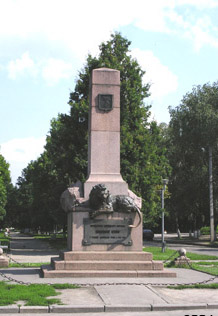|
 Alexey Stepanovich Kelin (Kelen) (?-1715) fought in many
battles of the Great Northern War of 1700-21, including
Noteborg (1702), Nyenskans(1703), Dorpat(1704),
and Narva(1704). In 1708 he was given command of the
Tverskoi Infantry Regiment, and in December of the same
year Tsar Peter I appointed him commandant of the
Poltava Fortress.
Alexey Stepanovich Kelin (Kelen) (?-1715) fought in many
battles of the Great Northern War of 1700-21, including
Noteborg (1702), Nyenskans(1703), Dorpat(1704),
and Narva(1704). In 1708 he was given command of the
Tverskoi Infantry Regiment, and in December of the same
year Tsar Peter I appointed him commandant of the
Poltava Fortress.
From April to June 1709 the garrison led by
Kelin succeeded in holding the fortress against the Swedish
army’s siege. In 1710 he was promoted to
major-general in recognition of his battle merits.
The monument to Colonel Kelin, the commandant
of the Fortress of Poltava, and its defenders was erected on the site
of one of the bastions of the fortress through the efforts of General of Cavalry, Baron Alexander Alexandrovich
Bilderling.
Baron Bilderling was well known not only for
his important publications on military history but also for the
numerous monuments he designed. He created monuments
to the famous geographer and traveler
Prszevalsky in St. Petersburg, to Admiral Nahimov in Sevastopol,
and to the Swedish warriors killed in the Battle of Poltava.
The official dedication ceremony for the
monument took place on June 27, 1909 in the presence of
Emperor Nikolai II. Made of granite, it was originally crowned
by a double-headed bronze eagle which was
dismantled soon after the Revolution of 1917. There is a
reclining bronze lion on the pedestal. The pedestal bears
the inscription: “To the valorous Commandant of
Poltava Colonel Kelin and the glorious defenders of the city
in 1709.” On the opposite side there is an inscription relating
the events of the siege of the fortress by the Swedish
army of Charles XII from April to June 1709.
During the German occupation of Poltava in 1941-1943
the bronze details of the monument were dismantled
and taken to
Germany. After WWII the monument was reconstructed
in its original form except for the bronze eagle.
|
 History
History
 Dates and events
Dates and events
 Persons
Persons
 Poltava
Poltava
 Sights
Sights
 Photo gallery
Photo gallery
 Maps
Maps
 Virtual Museum
Virtual Museum
 Armament
Armament
 Uniforms
Uniforms
 Coins and medals
Coins and medals
 Flags
Flags
 Paintings
Paintings
 Poltava photographs
Poltava photographs
 News
News
 About us
About us
 Acknowledgments
Acknowledgments
 Main page
Main page
 Photo gallery
Photo gallery
 top
top ...back
...back  Alexey Stepanovich Kelin (Kelen) (?-1715) fought in many
battles of the Great Northern War of 1700-21, including
Noteborg (1702), Nyenskans(1703), Dorpat(1704),
and Narva(1704). In 1708 he was given command of the
Tverskoi Infantry Regiment, and in December of the same
year Tsar Peter I appointed him commandant of the
Poltava Fortress.
Alexey Stepanovich Kelin (Kelen) (?-1715) fought in many
battles of the Great Northern War of 1700-21, including
Noteborg (1702), Nyenskans(1703), Dorpat(1704),
and Narva(1704). In 1708 he was given command of the
Tverskoi Infantry Regiment, and in December of the same
year Tsar Peter I appointed him commandant of the
Poltava Fortress.